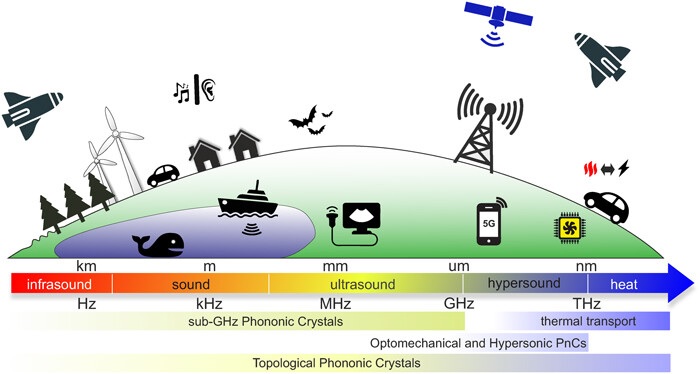Phononic Crystals
Phononic crystals (PnCs) control the transport of sound and heat similar to the control of electric currents by semiconductors and metals or light by photonic crystals. Basic and applied research on PnCs spans the entire phononic spectrum, from seismic waves and audible sound to gigahertz phononics for telecommunications and thermal transport in the terahertz range. Here, we review the progress and applications of PnCs across their spectrum, and we offer some perspectives in view of the growing demand for vibrational isolation, fast signal processing, and miniaturization of devices. Current research on macroscopic low-frequency PnCs offers complete solutions from design and optimization to construction and characterization, e.g., sound insulators, seismic shields, and ultrasonic imaging devices. Hypersonic PnCs made of novel low-dimensional nanomaterials can be used to develop smaller microelectromechanical systems and faster wireless networks. The operational frequency, compactness, and efficiency of wireless communications can also increase using principles of optomechanics. In the terahertz range, PnCs can be used for efficient heat removal from electronic devices and for novel thermoelectrics. Finally, the introduction of topology in condensed matter physics has provided revolutionary designs of macroscopic sub-gigahertz PnCs, which can now be transferred to the gigahertz range with advanced nanofabrication techniques and momentum-resolved spectroscopy of acoustic phonons.

References:
Progress and perspectives on phononic crystals, Vasileiadis, T., Varghese, J., Babacic, V., Gomis-Bresco, J., Navarro Urrios, D., Graczykowski, B. Journal of Applied Physics 131(18), 180901(2022), Phonon transport in the gigahertz to terahertz range: Confinement, topology, and second sound, Vasileiadis, T., Reparaz, J.S., Graczykowski, B. Journal of Applied Physics 131(18), 180901 (2022).